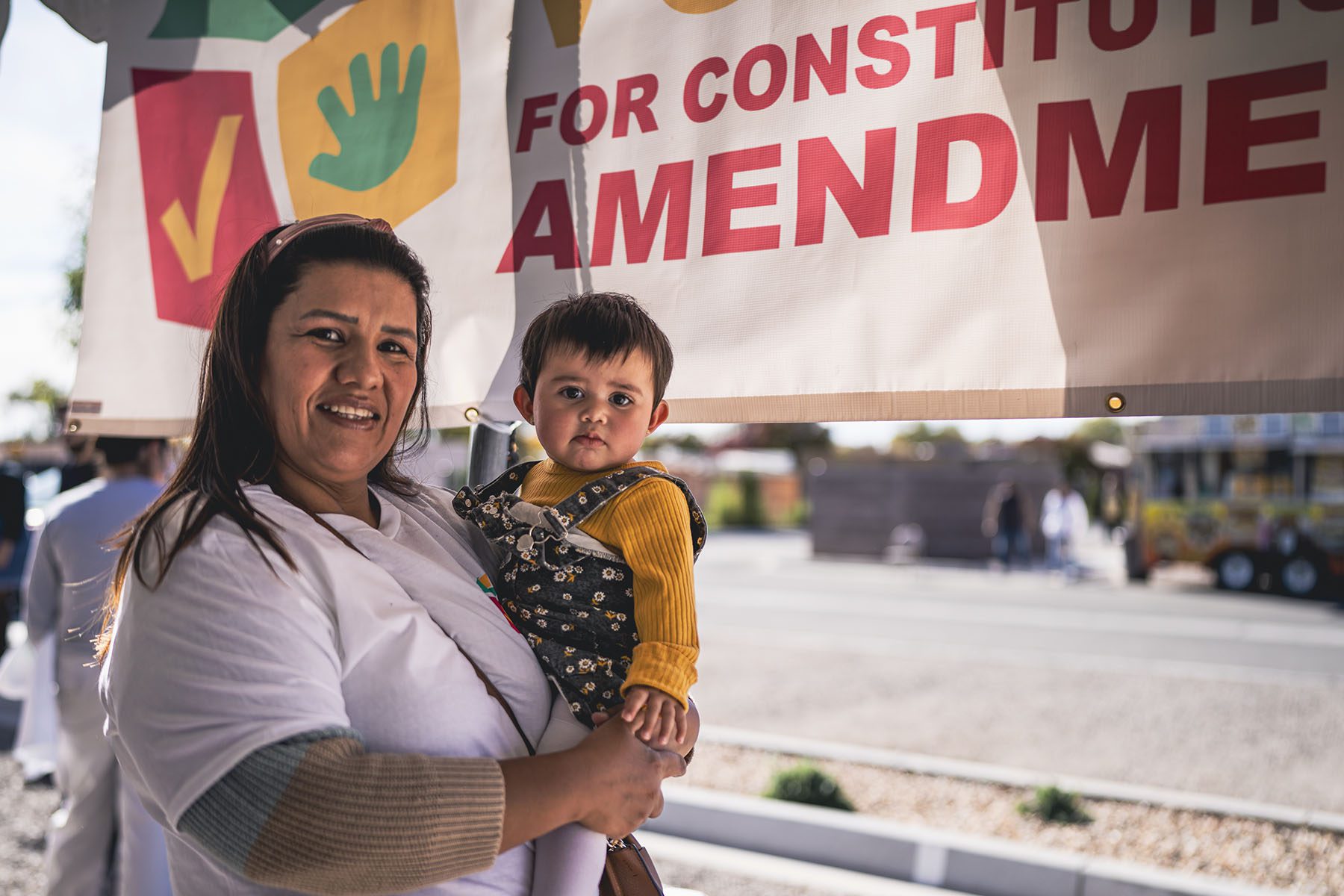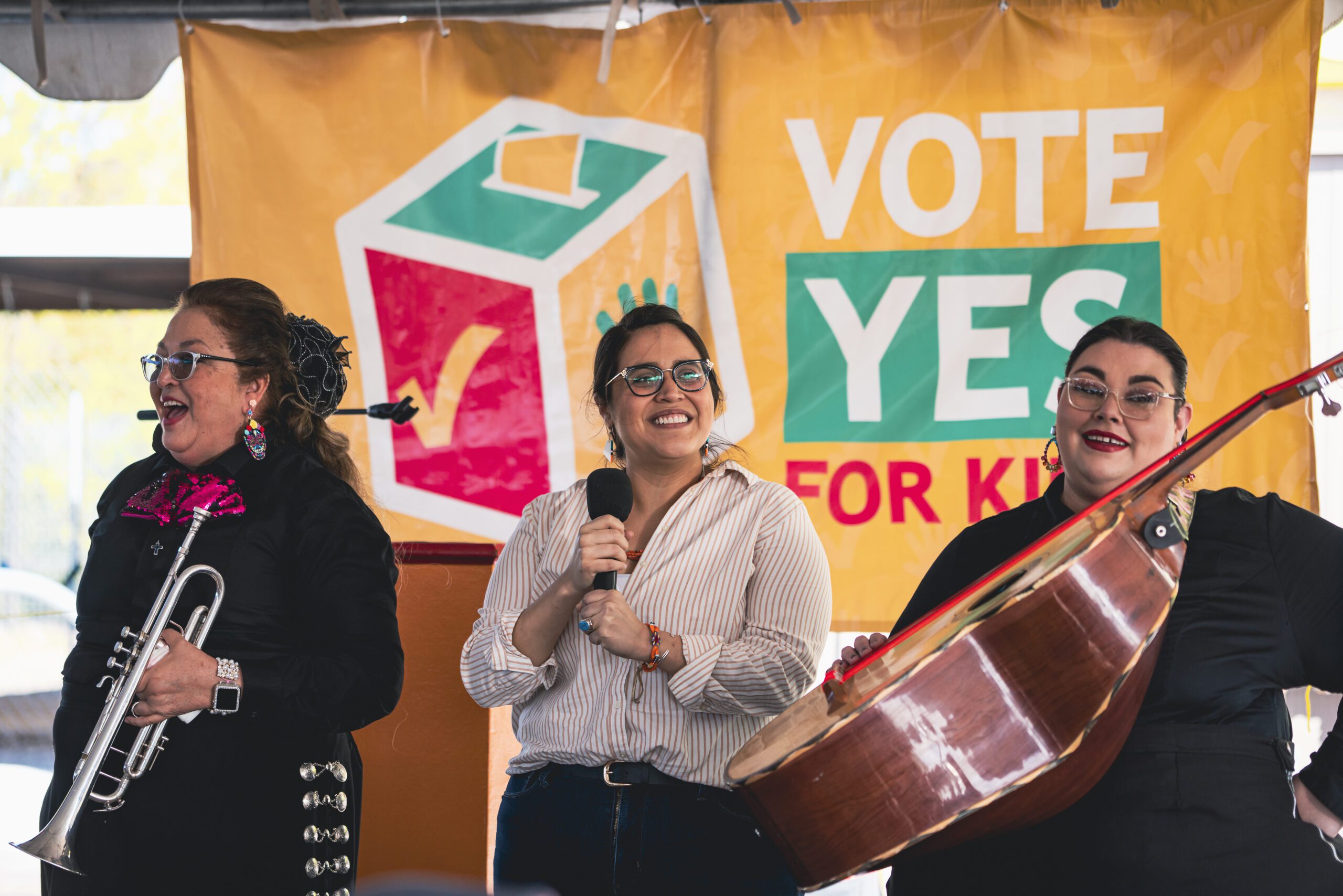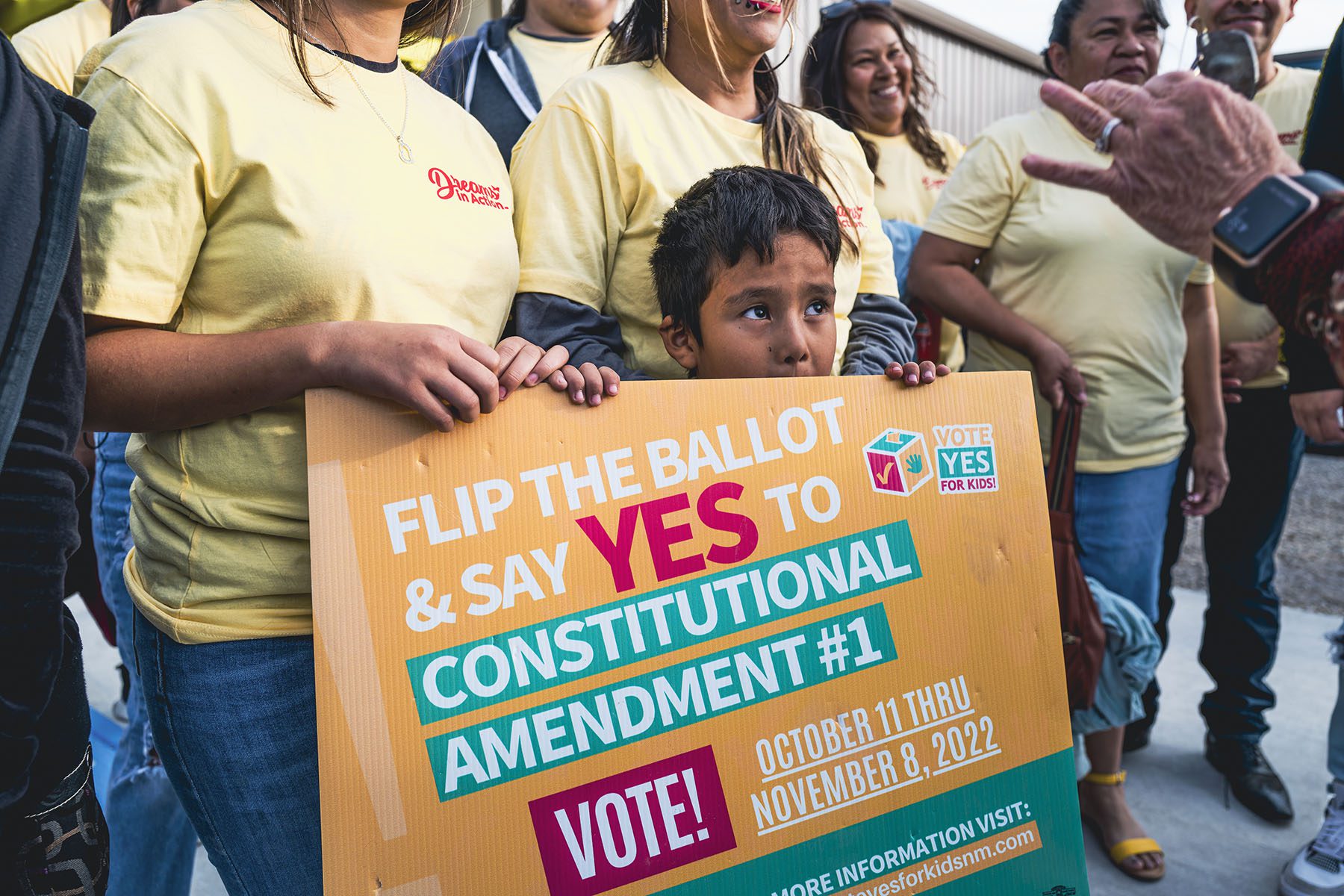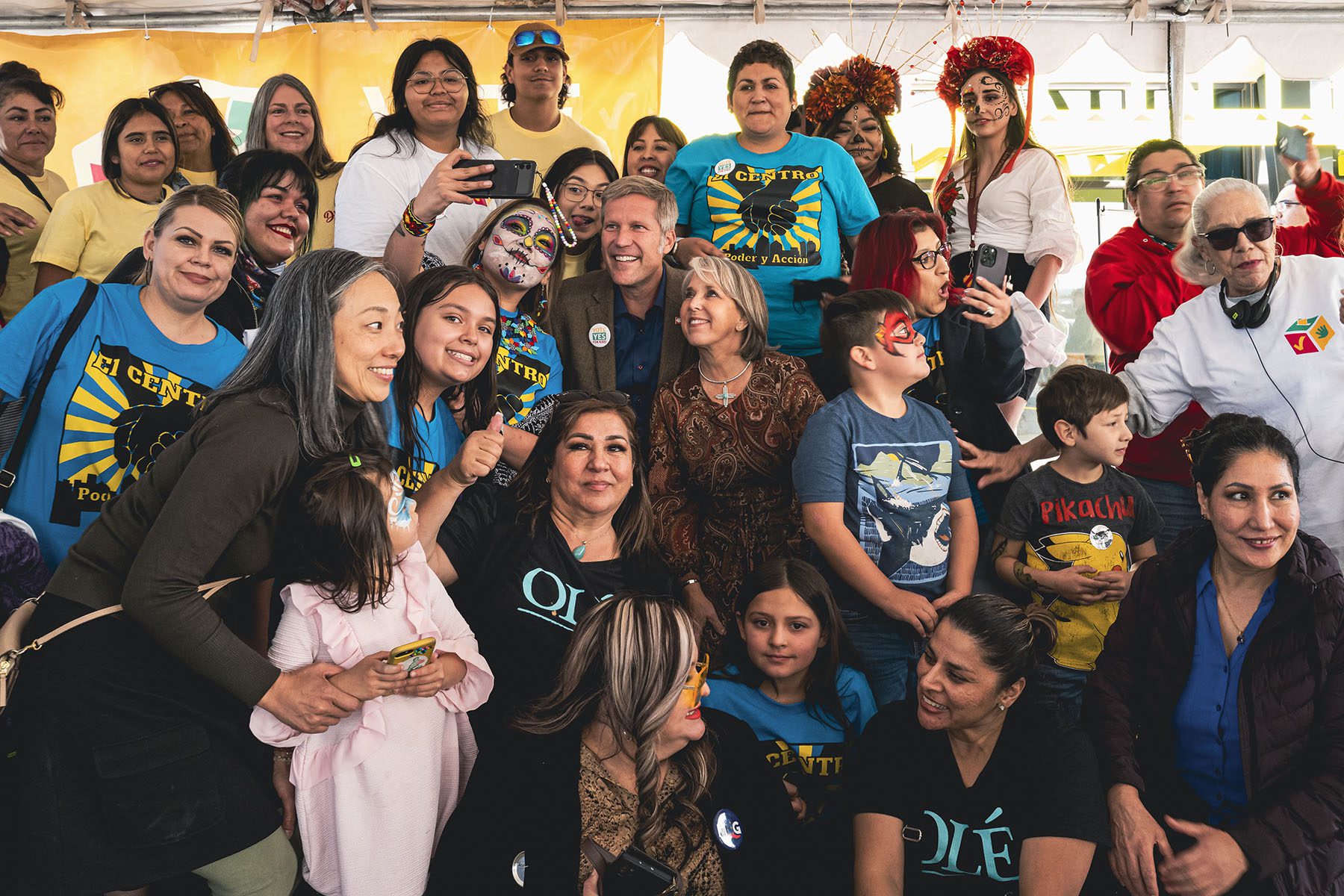We’re telling the untold stories of women, women of color and LGBTQ+ people. Subscribe to our daily newsletter.
Merline Gallegos’ child care center has been on the verge of closing many times. She’s long struggled to pay her workers the wages she believes they deserve, and when the pandemic hit, things only got worse.
“We were going to close or we needed to find some help,” Gallegos, 36, of Las Cruces, New Mexico, said in an interview conducted in Spanish. Her workers were losing hope; Gallegos’ family struggled to make ends meet.
Around the same time, Gallegos was invited to a meeting about a state fund filled with so much money that it could turn around the hardships of not just her own center, but of the entire state’s child care system. It’s your money in that fund, the organizers told the group. They just needed to get New Mexico voters on board.
The first thing Gallegos noticed was that the meeting was held in Spanish and the people in the room were almost all Latinas, she said. Like Gallegos, more than half of New Mexico’s early education workers are Latina.
“The inclusion of our community was interesting,” she said. “I wanted to be part of the change.”
Gallegos and thousands of child care workers across the state are now celebrating the overwhelming success of a constitutional amendment that will push lawmakers to tap into that state fund, seeded by profits from the state’s oil and gas, and pour millions of dollars directly into its early childhood education system.
As the nation grapples with a persistent child care crisis, other states are looking to New Mexico as a model of what is possible. The people behind the successful effort to rally statewide support for better funding of the state’s system say it took a decade of advocacy by child care workers steeped in the hard reality of low wages and underfunded classrooms, and a campaign that energized these workers — nearly all women, and predominantly Latinas — to take their pleas directly to the doors of voters across the state.
The result is millions in new spending on child care that will make permanent reforms ushered in by Democrat Michelle Lujan Grisham, the nation’s only Latina governor, and Early Education Secretary Elizabeth Groginsky, and paid for with temporary federal COVID-19 relief dollars. The top line: The state will pay child care providers more money per child, more families will be eligible to receive free child care, and workers will get permanent raises of $3 over what they were making before the pandemic, creating a floor of $15 per hour. Advocates hope more raises will follow.
The New Mexico legislature is slated to approve these plans in the coming weeks, a momentous achievement after years of advocacy work led by the women who spend their days caring for New Mexico’s youngest residents, and 11 months of relentless grassroots campaigning leading up to the referendum.

“At the end of the day, the field operation was mainly impacted folks — child care providers and the families in need of child care. It was women, nonbinary folks and youth of color. That was our field operation across the state,” said Eli Cuna, the campaign manager for the Vote Yes for Kids coalition behind the constitutional amendment. “The message was that this is your money, and you have the opportunity of a lifetime to decide what happens to it.”
The opportunity to pass the referendum was teed up by a decade of work that started with a simple premise: Convince policymakers and the public of the value of child care workers at a time when they felt derided as no more than babysitters. Then, secure enough votes to put a referendum on the ballot that would boost funding for the state’s child care system.
Carmela Salinas, a preschool teacher in Espanola, New Mexico, said she first started working with the campaign in 2011, when she attended a meeting organized by the nonprofit Organizers in the Land of Enchantment, better known as OLÉ, about the dire needs of New Mexico’s child care system. At the time, New Mexico ranked 31st among the states on total spending on young children, and the state didn’t fund care for any children under the age of 4, according to data from the National Institute for Early Education Research.
“I didn’t know anything about politics,” said Salinas, who has since become a key voice for child care workers in New Mexico. “They said, if you had a magic wand, what would you want? And I said something about better classroom materials for the children. I wasn’t even thinking about money. I thought this was just the wage we got.”
The more she got involved in advocacy work, particularly appeals to state leaders, the more energized she became.
“What really lit a fire under us was how disrespected we felt,” Salinas said. “I looked around and thought, what do we all have in common? We’re women, predominantly women of color, and you’re not asking us. You don’t think we’re educated enough.”
Little by little, the landscape started to change, Salinas said. Both Gallegos and Salinas said they have hosted state lawmakers in their child care centers to show them the work that goes into caring for and educating young children. Some lawmakers were really receptive to the message; others were replaced with candidates who supported their cause, in part thanks to the child care coalition’s efforts.
Salinas said that when she started out, her salary was just above minimum wage. She spent 19 years at the same child care center and, after obtaining a bachelor’s degree, began working in the public school system as a preschool teacher. She describes her departure as one of the pitfalls of a system that can’t pay as well as the public schools can: She hopes to see them better able to retain experienced and qualified workers once funding from the referendum translates to a ladder of raises for experience and education.
Once the measure was approved for the ballot, advocates said, the work involved disrupting narratives about child care among voters, especially those who didn’t directly need it. That involved engaging with Hispanic voters themselves. More than half of New Mexico residents are Hispanic or Latinx, according to the U.S. Census, and 44 percent of all eligible voters are Latinx, the largest share of any state, according to the Pew Research Center.
Gallegos said she was sometimes met at the door by abuelitas who said they didn’t trust child care centers and, late into their retirement, were working to care for their grandchildren. Engaging them in their native language and with cultural context helped improve their view of child care centers and illustrate their value for young children and families who don’t have other options.
“I would tell them that I was raised by my grandmother. She was my treasure. But children also need socialization and education, and we can offer that,” Gallegos said, adding that for children with special needs, the child care setting can be really beneficial. “The more you explain about the work you do, the more people better understand how we’re really a support system for many children.”

Cuna said some of the pushback she saw at the doors hinged on a lack of understanding of the burdens women, particularly low-income women, face when trying to work and parent.
“The truth of the matter is that misogyny is so internalized in us that we cannot see the importance of child care and child care workers,” Cuna said. “When we were hearing some negativity from the doors, it was, ‘Well, kids should be with their parents, not at a day care.’ That’s coded language for, kids should be with their mom.”
Cuna said that part of the reason why the campaign was so successful is that its goals seemed to align with many of the desires and hardships advocates were hearing from Latinx residents in New Mexico. She recalled one listening session when the top three issues rising from the group were lack of child care for Latinx workers; challenges resulting from the lack of immigration status, especially in mixed-status families; and the need for more opportunities to build long-term careers, “to grow in whatever job they had.”
New Mexico’s child care referendum held the promise of helping address the first two challenges: secure and expand affordable and quality child care for working parents, and improve career opportunities and wages within a field that already employs many Latinas.
“This creates a lot of opportunities for the working class, mainly Latinos in rural areas, in southeast New Mexico. They can do something besides what they are currently doing,” Cuna said.
Cuna added that the survey also showed that Latinx people in the state felt blocked from economic opportunity and political advocacy by the lack of engagement in Spanish. She said the work of her coalition was arming Latina child care workers and mothers with “information and agency.”
Gallegos said the outreach earned her support. “That cultural respect is a key motivator to support an organization like this,” she said, referring to the coalition behind the Yes for Kids Campaign and OLÉ.
The work to build up child care as a sustainable career path in New Mexico is far from over.
Later this year, the state’s Early Childhood Education and Care Department is expected to ramp up work on a professional wage and career ladder that could ultimately guarantee wages and raises for child care workers based on professional experience and higher education.
Some workers, like Gallego, are invested in seeking higher education. Right now, she’s working on her associate’s degree, which, in practical terms, means that her work day starts at 6 a.m., followed by classes until 8 p.m., followed by assignments and household tasks at home afterward.
Still, advocates for the state’s child care workforce say the state will have to be careful when promoting higher educational attainment among child care workers. Educators whose primary language is Spanish may not as easily or quickly obtain an associate’s degree, particularly in rural parts of the state. For others, the hurdles may simply be the demands of life, like caregiving for their children or elderly family members.
“We want to make sure it rewards experience and compensates people who have been earning poverty wages in this field for a decade or two,” said Matthew Henderson, the executive director of OLÉ, which is planning to work with the state on this issue. “Both because we think experience is very valuable, and because it’s essential to preserve our early childhood workforce — one that looks like the student body it serves.”

The wage and career ladder that will be developed by the Early Childhood Education and Care Department in the coming months is expected to come before New Mexico legislators for approval in 2024. Advocates are already in the halls of the legislature educating policymakers on what it will take to create the early childhood education workforce they want to see.
“I legitimately believe that the strategy for this campaign was designed and led directly by impacted workers, creating a coalition that people could connect to,” Cuna said. “Now in the negotiation piece, it must be also directly impacted folks in the front — the folks closer to the challenges.”
Cuna found out she was pregnant with her first child shortly after she began working on the campaign to pass the constitutional amendment. The inspiration that would carry her through to success in November came during a trip for the campaign to the colonias, a collection of border communities along the Mexico border that are overwhelmingly Hispanic and poor.
When she got there, las promotoras — older women promoting the referendum — were telling stories about crossing into the United States, looking for work, but having no one to take care of their children. They saw her pregnancy and told her about continuing to work right after giving birth.
Their daughters, they said, deserve to have child care for their own children.
“Era pura señoras — it was all women, Latina women, with accents, working their asses off,” Cuna said. “They’re not asking for the spotlight. They believe that they can change the reality of the upcoming generation. This campaign for me was about how resilient and powerful were our mujeres.
“A nuestra gente lo que no se le acaba es la esperanza.” Our people don’t lose hope, she said.







